Choosing thermal imager to facilitate electrical maintenance
By EPR Magazine Editorial November 13, 2021 1:42 pm IST
By EPR Magazine Editorial November 13, 2021 1:42 pm IST
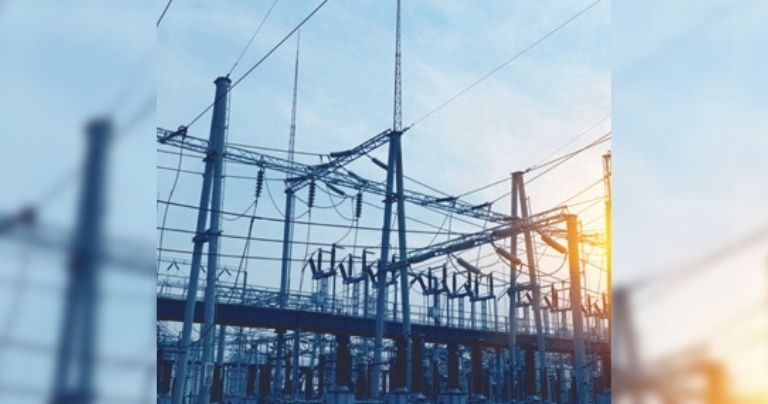
Five things to consider before choosing a thermal imager for electrical facility maintenance, according to Thermographers Co., Ltd.
Large-scale electrical fires were a common occurrence in electric utility power plants and factories in Japan in the early 2000s. Due to poor economic conditions at the time, facilities poured less money into necessary maintenance and repairs. It was around this time that thermal imaging cameras began drawing attention as an electrical inspection and diagnostics tool. Previously, thermal imaging cameras were more commonly used for research and development because of their cost and large size. But as thermal imagers have become smaller and more affordable they have been gradually introduced into electrical facilities for condition monitoring to identify problems without the need to shut down equipment.
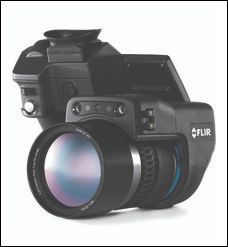 Shutdowns and equipment repairs can be costly. That’s why electrical facilities all over the world are switching to condition-based maintenance and routine inspections of equipment using thermal imaging. This technology has enabled facilities to routinely inspect equipment and make repairs as needed – before a failure occurs.
Shutdowns and equipment repairs can be costly. That’s why electrical facilities all over the world are switching to condition-based maintenance and routine inspections of equipment using thermal imaging. This technology has enabled facilities to routinely inspect equipment and make repairs as needed – before a failure occurs.
Thermographers Co., Ltd., is a team of specialists in Japan that offers thermography inspection services and seminars on gaining qualification as engineers in condition monitoring and diagnostics of machines (under the ISO 1826-7 international standard). Hirofumi Yamada, the company’s president and a thermography expert, offers up the following five things to consider before choosing a thermal imager for electrical facility maintenance.
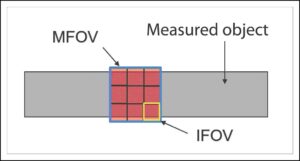
Emissivity
An understanding of the infrared properties of a material is important in determining whether you are observing a true or a false hot spot. Electrical connections and contacts are made of or plated with metal to prevent radiation heat; the emissivity of the metal parts tends to be low. Emissivity varies between 0 and 1.0. The lower levels reflect, while the higher levels emit infrared energy. Depending on the thermal camera used, the emissivity must be correctly set to get an accurate temperature reading.
Temperature under no load
It is also important to know how much load the facility operates. For example, if there is an increase in temperature but it is unclear whether the increase is caused by the properties of the facility or by a failure, then it is impossible to make a diagnosis. It is necessary to understand the relationship between degradation failure temperature and heat generation, including whether the temperature increase is adequate for the load.
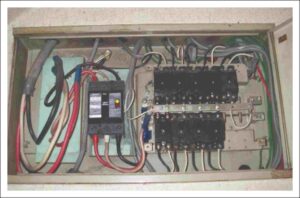
Power distribution panel with loosened screws (digital camera)
MFOV is the spatial resolution necessary for measurement. In the camera specifications, the instantaneous field of view (IFOV) is often specified. This corresponds to the angular projection of a single pixel. For accurate measurement we need to cover a larger area (approximately 4×4 pixels), which is called the MFOV. Premium cameras have a high detector resolution and good optics, which help with IFOV and MFOV, allowing you to accurately measure small targets at a larger distance than you can with lower resolution cameras.
Degradation
Using thermal imaging cameras in electrical facility maintenance requires the knowledge of degradation failures, including what kinds of degradation failures or losses may occur. Electrical facilities are often located outdoors, exposed to outside air, so they degrade naturally. Their degradation varies, depending on their operating environment, materials, design, and how they are used and put under load. According to Yamada, the occurrence of an accidental failure or disaster makes predictions more difficult. “You should keep in mind that the average service life of electrical facilities is not necessarily as specified by their manufacturer,” he says.
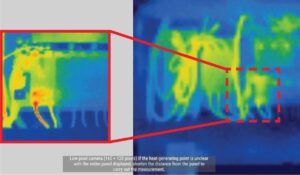
According to Yamada, using a thermal imager for inspection is more complex than users expect. “Many think they can discover high- temperature locations and degradation failures by simply using a camera. But to measure, you need a certain level of experience and knowledge to carry out the diagnosis,” Yamada says. “Temperatures may increase or decrease depending on the degradation, as described in examples in the ISO textbook. It is necessary for the user to understand, to a certain extent, the relationship between degradation failures and temperatures, and infrared theory including relevant physical laws.” Without general knowledge of degradation failures, it is impossible to make a diagnosis using a thermal imaging camera.
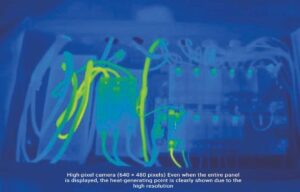
Don’t fixate on ‘price’
Typical users tend to care most about price when purchasing their first thermal camera. However, Yamada says, “Less expensive cameras are more suited for experienced users, and beginner users should purchase a premium camera.” Low-priced cameras have limited functions, so their effective use requires experience and skill, while premium cameras have functions that compensate for the measurers’ inexperience, including the ability to shoot high-precision images of wide areas. Focus on choosing the right camera with the right functions, so problems can be accurately diagnosed.
With these five things in mind, every electrical facility can successfully incorporate a thermal imager into an inspection routine. Through regular condition monitoring using FLIR thermal imaging technology, electrical facilities can reduce equipment failure, expand life cycle, and lower overall costs.
For more information, please visit: www.teledyneflir.in/ electrical or write to us at flirindia@flir.com.hk
We use cookies to personalize your experience. By continuing to visit this website you agree to our Terms & Conditions, Privacy Policy and Cookie Policy.